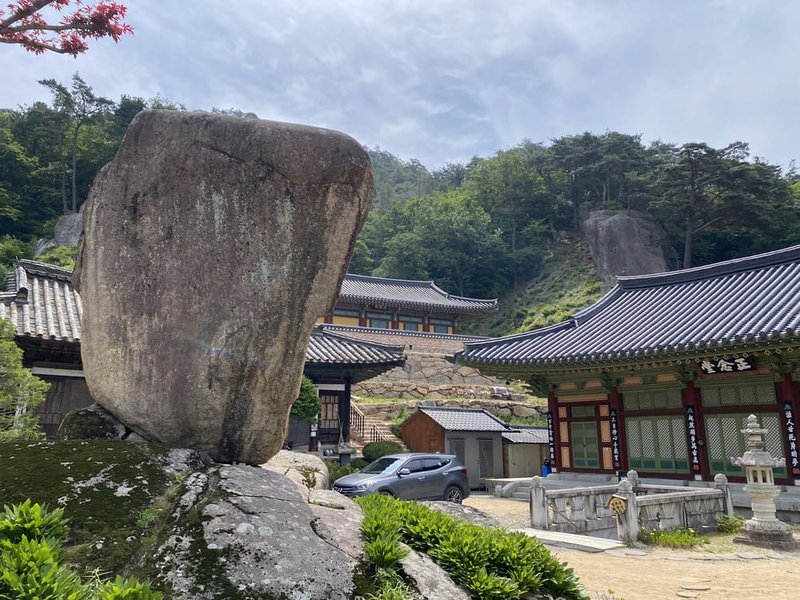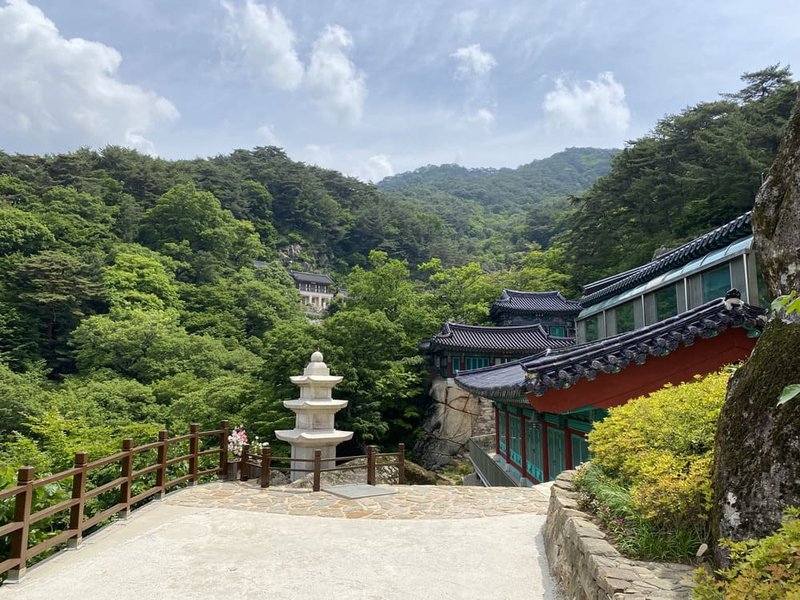When I learned about the Three Jewel Temples and the Tripitaka Koreana during my visit to Tongdosa, I wanted to visit Haeinsa. From the Three Jewels - Haeinsa represents the Dharma (The Buddhist Teachings). It houses the wooden Tripitaka Koreana. Haeinsa is about two hours from Busan, where I live, so I decided to make this trip a temple stay. A temple stay is a night at the temple filled with activities to learn more about the temple and experience the life of a monk. And for multicultural Korean families you can experience it this year completely free of charge.
When you enter the park you pass a huge gate where you pay for parking. We planned to have lunch before heading to the temple, so I started doubting whether I put the right destination in the navigation. It turns out that the whole area is huge.
The restaurant was a couple of kilometers into the area. After passing some smaller restaurants along the road and passing the road that leads to the temple, you suddenly enter a small village. The village has high-rated Hanjeongsik (Korean-style food with 1 main dish and a table full of side dishes). We arrived early, but it was Memorial Day, and the waiting line for our restaurant of choice was over an hour. Luckily, a couple doors down the street there was another one. Food in the countryside hits differently. Every dish laid out on the table was super fresh. Even the water tasted fresh. And the doenjang-chigae had the deepest flavor I've tasted so far.
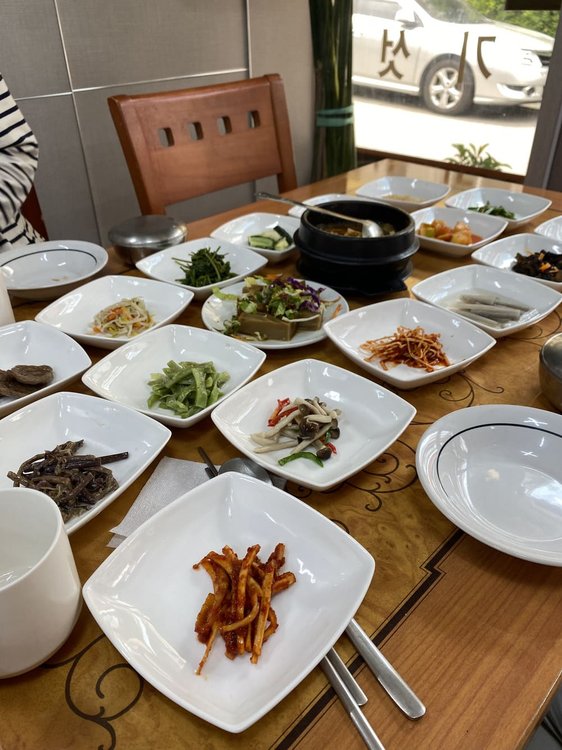
After lunch, we drove to Haeinsa. We arrived just before 2:00 PM, but even though check-in would open at 2:30PM, we were warmly welcomed by the English-speaking volunteers. She gave us our uniforms, mattress covers, and the room key. The English orientation started at 5:00PM, so by the time we were all settled and freshened up - we had a good 2:30 hours to look around the temple by ourselves.
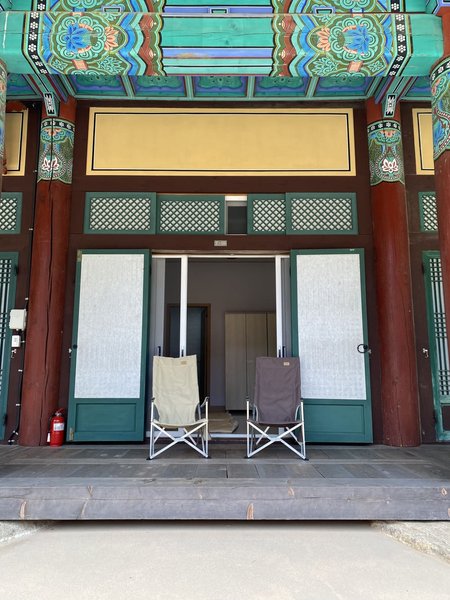
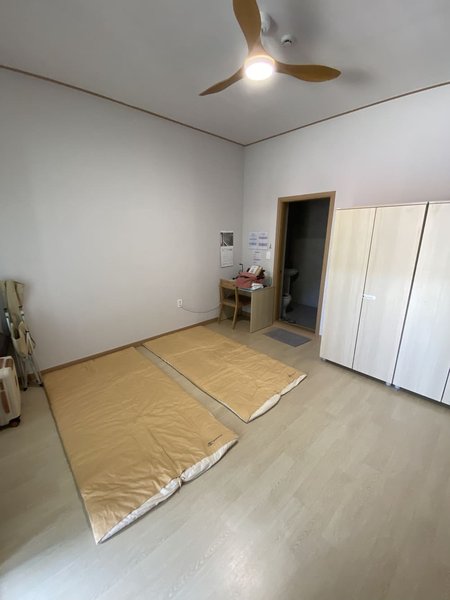
The main area of Haeinsa is a short walk from the accommodation. You first see the Bell Pavilion with a large one-way maze-like square in front of it. We later learned the maze is shaped like the Haein-do diagram, the Dharma map. It visually represents a poem that summarizes the core ideas of Huayan thought (A Buddhist philosophy). A walk through the maze, ideally while chanting the poem, can be interpreted as the path to enlightenment.
At the entrance (and the exit) of the maze, next to the book cafe, there are stairs to the second level of the temple. Here is a three-level pagoda with a stone lantern in front. I have seen people bowing to the pagoda before, but I never wondered why. Little did I know that it represents Bhudda's grave. The stone lantern in front of it means the light of the Dharma. I've seen so many temples and only learned this now?
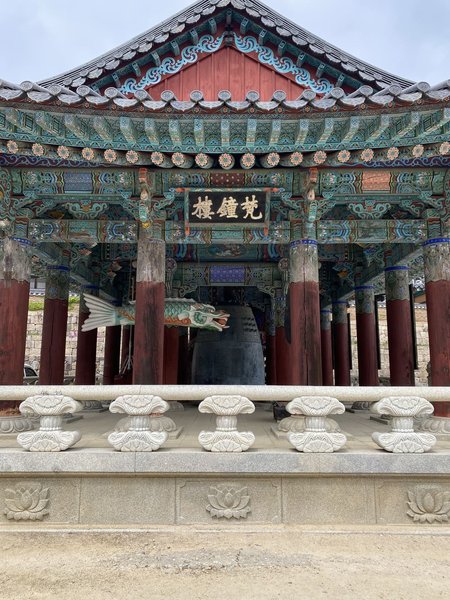
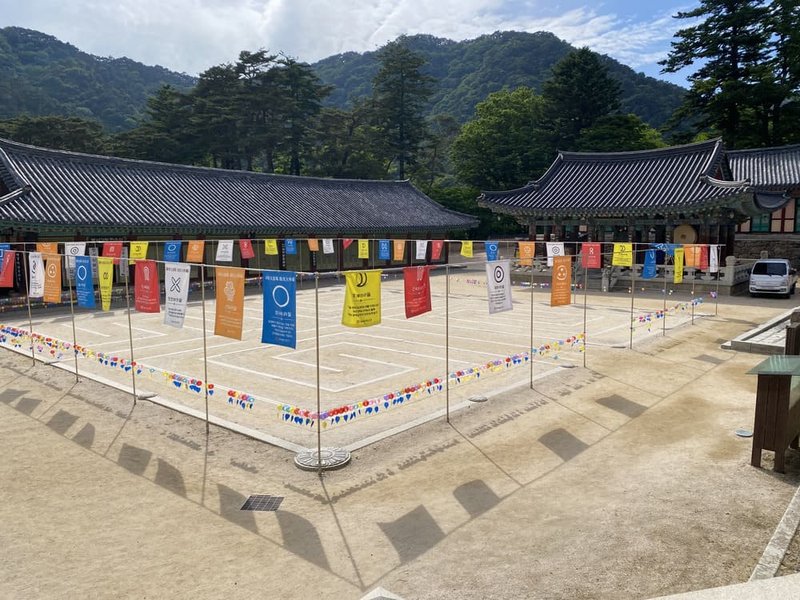
On both sides of this square, there are the houses of the monks. The monks on one side, and the students on the other side. They sleep in one big open space. One burning question I had, that I didn't end up asking, was how they deal with mosquitos. I guess that will remain a mystery forever.
If you go up the stairs again you'll find the main ceremony hall, a smaller hall housing twin Buddha statues, and a golden statue of Choi Chiwon, a philosopher and poet in the late Unified Silla period, who turned to Buddhism in his final years in and around Haeinsa. Our guide explained later during the tour that the hall with the twin statues has fire detectors, and when fire is detected the twin statues automatically descend 6 meters into the ground into a fire-safe environment.
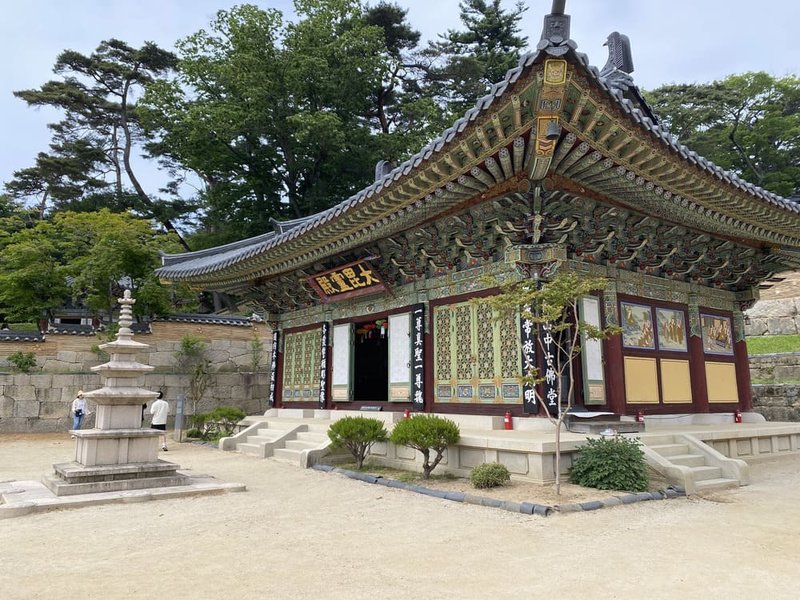
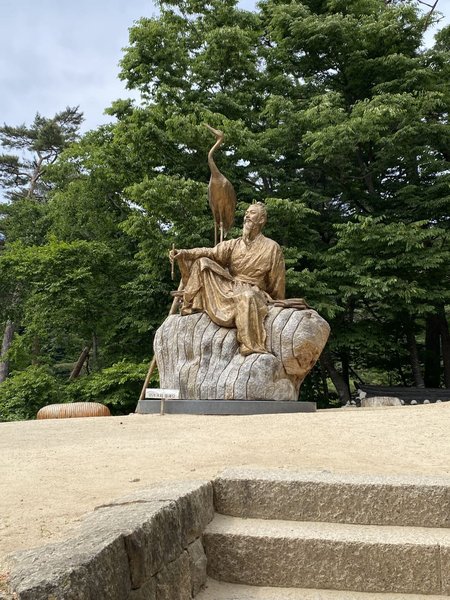
If you have read my blog about Tongdosa, you know Haeinsa houses the Tripitaka Korean. Woodblock scriptures containing the Buddhist canon. We were told we couldn't go inside because it's only open on Sundays. I was afraid I could not see anything at all, but luckily you can still walk through a passage and watch the Tripitaka Koreana, through bars, in full glory.
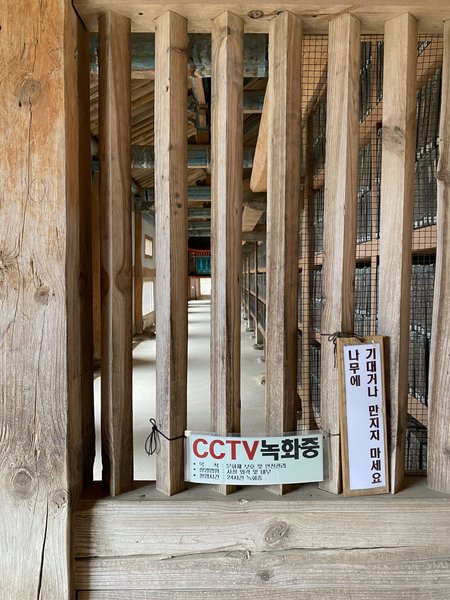
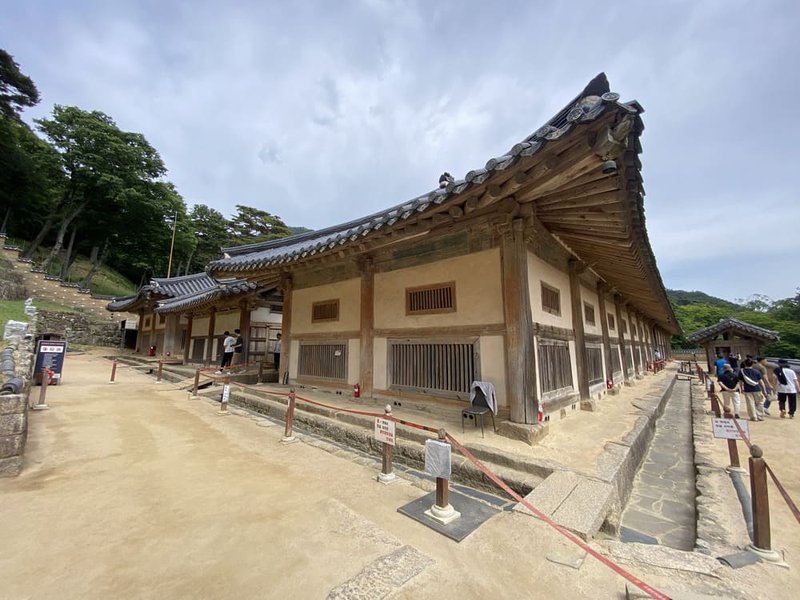
At five we joined the introduction. This was a brief introduction to the history and significance of Haeinsa, things to explore in our free time, and temple etiquette. After we learned how to walk, bow, eat, and behave we had a tour of the property. The tour ended in the main ceremony hall. She showed us how to perform a full bow during the ceremony. After 3 full bows to Buddha, the tour was finished and we headed to the cafeteria.
Buddhist monks do not eat meat. Together with alcohol and cigarettes, alcohol is forbidden on the property. There were no other animal products at dinner either. We had a vegan, quiet meal. During the introduction, we were told it's not allowed to talk during meals, unless absolutely necessary. Army style, she jokingly said. It's important to be present and appreciate all the hard work and effort put into preparing the food. So when we entered the cafeteria, we grabbed a plate, put rice and different types of veggies on our plate, and ate silently.
After dinner, we headed to Bell Pavilion where the evening instrument ceremony was held. Usually performed by first-year students. We were lucky the drum was renewed that day, and it was initiated by fourth-year students. It sounded great, but I don't know if I, an untrained ear, would've heard any difference.
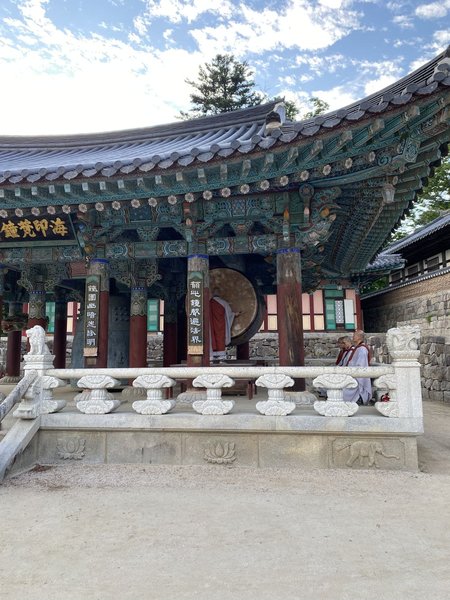
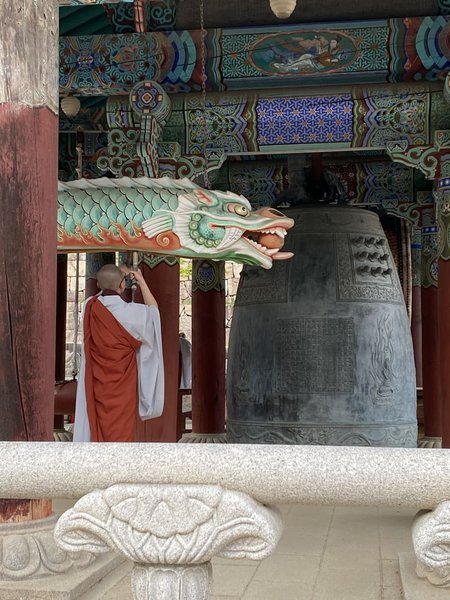
After this, we headed back to our room. From 8:00 PM it's not allowed to walk around the property anymore. When the instruments are finished, monks study for an hour and sleep at 9:00 PM. They sleep until 4:00 AM and will go through the same rituals again. Our first activity started at 4:40 AM the next day, so we went to sleep early as well.
I woke up slightly stiff. The floor mattress had the thickness of a winter blanket. My back feels great after sleeping on the floor for several days, but the first night is always rough. With the alarm at 4:00 AM, I felt like a monk already.
At 4:20 we gathered in front of the accommodation. Almost everyone from both (Korean and foreigners) groups joined. Every activity is voluntary so I expected more people to skip the first activity and sleep until breakfast. 6:00 AM that is. A monk led us to the main ceremony hall. Upon entering the property we heard the same, battle-like, drums we heard last night. They got me fired up at 4:00 in the morning. When we arrived at the ceremony hall we all got a mat and were placed in the corner. We followed their lead with their bows and listened to their prayers for around 20 minutes.
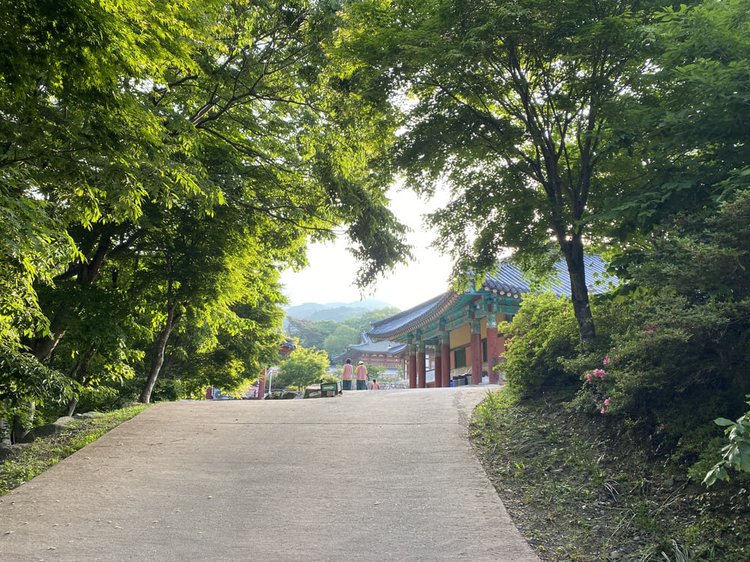
After that, we had 1 hour of free time before breakfast. There are not many things you can think of doing at 5:00 AM, so we went to the tea house and relaxed until breakfast was ready. When we arrived at breakfast a monk announced it with a small bell. After the monks went inside, we followed and had another quiet meal. The menu was Kimchi-kongnamul-jjuk. I absolutely love this food, but I can imagine not every foreigner is excited about this at 6:00 AM. There was also an interesting-looking marinated cold bean mixture that I had never seen before. I scooped some extra of these to get enough protein.
After breakfast, there was some free time and two optional programs. During the introduction, the guide mentioned that mainly kids sign up for these. We decided to skip this and explore some of the more interesting options she gave us. There was a Buddha statue carved out of stone on the mountain that I wanted to see.
The sign said it was 2KM. The guide told us it was about an hour's hike. I have long legs, and I mistakenly assumed it's probably not that far... It was that far. Monks visit the stone Buddha when they have something on their minds and need to clear it. They hike up the mountain and do their prayers. While I was struggling my way up, a friendly monk was on his way down. He greeted me with a smile and continued his journey humming a song. I guess it worked for him.
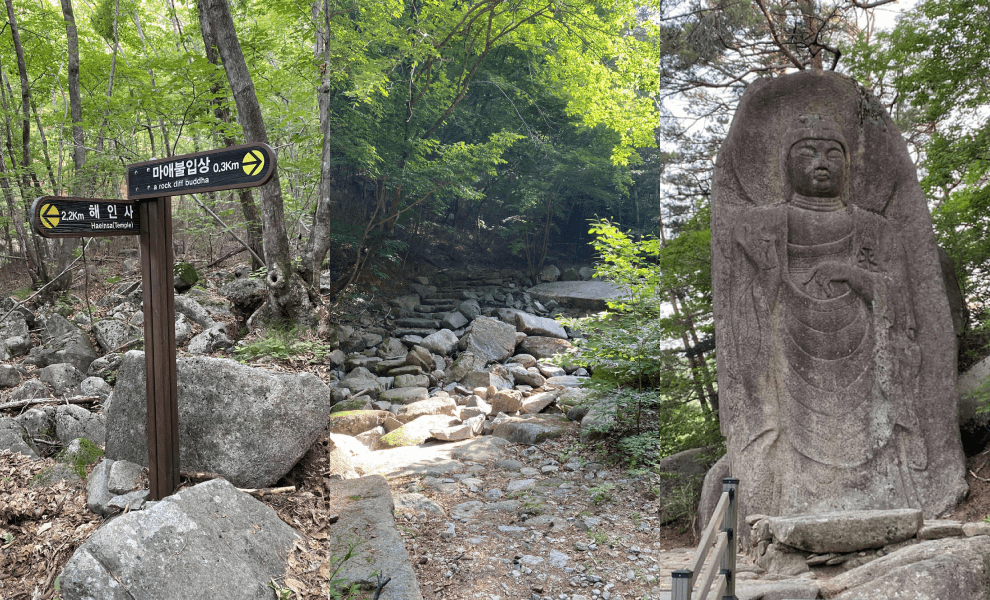
When I finally got up I was surprised by the statue's size. It was a lot bigger than I expected. I started hiking straight after breakfast, where others went to their room. So when I arrived at the top I was there all by myself. I heard the sounds of water streaming down the mountain. Birds were singing. And the sun was shining. It was truly a peaceful moment.
I headed down the mountain. Back in the room, we decided to check out early and visit some of the smaller temples in the mountains. They take up to 1 hour to reach by foot, but luckily you can drive there. I showered, cleaned the room, dropped the laundry at the designated area, and we headed to the other temples. Each of these smaller temples houses an interesting artifact. I was struck by how beautifully they blend into the surrounding nature, and it left me feeling that I would like to stay in a more intimate temple like this one time.
